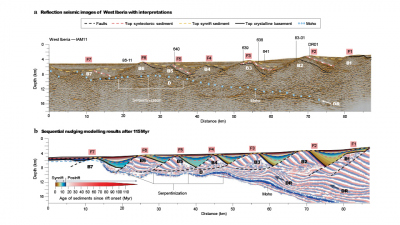- Home
- Discover
- Media Releases
- Media Releases 2023
- Rifted Margins
Better understanding on the way to a carbon-neutral economy

Pangaea was the name Alfred Wegener gave to the supercontinent that existed on Earth 250 million years ago. Over the course of many millions of years, this supercontinent broke into different pieces, which became the landmasses we see on the globe today. Extensional forces on the tectonic plates causes continents to break apart – as Pangaea once did – creating new ocean basins. Large parts of these extended continents are not visible because they lie under water and are named rifted margins.
Continental margins harbor vast accumulations of globally distributed sedimentary, igneous and ultramafic rocks, adjacent to large coastal populations due to their geographic location. Until a few decades ago, such continental margins were divided into magma-rich and magma-poor. This classification followed the formation history of new ocean floor – but does not seem to encompass the full range of ways rift margins form. “These rifted margins are located on the coasts on both sides of the oceans and contain huge sediment accumulations, hydrocarbon reserves, and are a potential location of new resources needed for the new carbon-neutral economy,” explains Marta Pérez-Gussinyé.
The team of authors proves that other types have been identified in the meantime, which, according to Marta Pérez-Gussinyé and her colleagues, leads to a great variety of so-called continental margin architectures. They are based on different processes of magmatic, tectonic, sedimentary or hydrothermal nature. “The origin of rift margins is multifaceted, meaning that they have been formed in different ways. Unlike previous approaches, this overview gives us the opportunity to analyze rifted margins holistically,” explains first author Pérez-Gussinyé.
Her research group has pioneered the development of numerical tools to study rifted margins. These tools allow to combine data and models to understand the processes that shape margins. The authors have compiled the latest observations and theoretical results that should lead to a process-based understanding of margin formation. “This will be key to making accurate predictions in the future for the new storage and energy requirements needed to transition to a carbon-neutral economy,” Pérez-Gussinyé emphasizes.
Together with her co-authors, she concludes that rifted margins could play a central role in the transition to a green economy in the future: as potential carbon dioxide storage sites, as mineral deposits, or even as sources of geothermal energy and natural hydrogen. But before that, additional geophysical and geological data would need to be integrated into further research. “The paper shows how a combination of observation and numerical simulation of the processes that occur during continental rifting will help unlock this potential in the future.”
Some of the numerical models presented in the article are being developed and improved as part of the Cluster of Excellence “Ocean Floor” based at MARUM. They will help to better understand the formation of continental margins and oceanic crust and their role in the global carbon cycle.
Contact:
Prof. Dr. Marta Pérez-Gussinyé
MARUM - Center for Marine Environmental Sciences, University of Bremen
Geophysics – Geodynamics
Phone: +49 421 218-65350
Email: [Bitte aktivieren Sie Javascript]
MARUM produces fundamental scientific knowledge about the role of the ocean and the ocean floor in the total Earth system. The dynamics of the ocean and the ocean floor significantly impact the entire Earth system through the interaction of geological, physical, biological and chemical processes. These influence both the climate and the global carbon cycle, and create unique biological systems. MARUM is committed to fundamental and unbiased research in the interests of society and the marine environment, and in accordance with the Sustainable Development Goals of the United Nations. It publishes its quality-assured scientific data and makes it publicly available. MARUM informs the public about new discoveries in the marine environment and provides practical knowledge through its dialogue with society. MARUM cooperates with commercial and industrial partners in accordance with its goal of protecting the marine environment.
Pérez-Gussinyé, M., Collier, J.S., Armitage, J.J. et al. Towards a process-based understanding of rifted continental margins. Nat Rev Earth Environ (2023). DOI: https://doi.org/10.1038/s43017-022-00380-y
Participating institutions:
MARUM – Center for Marine Environmental Sciences, University of Bremen (Germany)
Department of Earth Science and Engineering, Imperial College London (Great Britain)
Sciences de la Terre et Technologies de l’Environnement, IFP Energies Nouvelles, Rueil-Malmaison (France)
Geological Survey of Denmark and Greenland, Copenhagen (Denmark)
Key Laboratory of Ocean and Marginal Sea Geology, South China Sea Institute of Oceanology, Chinese Academy of Sciences, Guangzhou (China)
Barcelona Center for Subsurface Imaging, ICM, CSIC (Spain)
ICREA, Barcelona (Spain)
More information:


